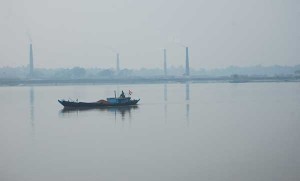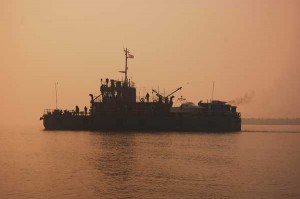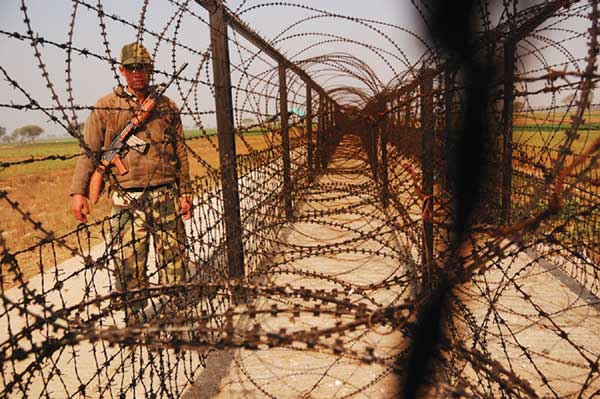Cattle Smuggling and Terrorism: Let’s come straight to the point. The cattle-smugglers of West Bengal, their knowledge of the border areas, the gaps and the vulnerable areas through which infiltration could happen, their contacts with cattle traders and truckers in the hinterland of India and their contacts with cattle merchants in Bangladesh, all of this combines to form a massive cross-country network. Can’t terrorists use this network to get in and out of the border? Yes, they can. If this perspective indeed generates a serious security scenario, then it’s important to understand Cattle Smuggling and its link to terrorism.
The Subverted Indo-Bangladesh Border : I
The Subverted Indo-Bangladesh Border : II
Few days after I reached the border areas in the Murshidabad sector in West Bengal, I was told there was intelligence about a group of cattle smugglers who planned to take hundreds of cattle across the border. One facet that is not known is that after 6 pm the deployment in the eastern frontier switches into a combat-ready mode. Every day in many sections of the border cattle smugglers attack border guards. Lonely alert soldiers manning 500 metre stretch each are vulnerable to a sudden attack in pitch darkness.
 Soldiers are attacked with knives and sickles and other sharp weapons. I received information that a group of cattle smugglers has struck again, breaching an improvised fence to take cattle from India into Bangladesh. When I reached the spot, I met G. Srinivas, a BSF solider: “This place has a makeshift border fence of barbed wire and bamboo to stop people from crossing over. At 5:30 pm some cattle crossed over from here. When cattle smugglers operate there are 5-6 men to every animal. They are received by Bangladeshis on the other side. They keep in touch via mobile phones.” I asked, “How do they get the cattle across?”
Soldiers are attacked with knives and sickles and other sharp weapons. I received information that a group of cattle smugglers has struck again, breaching an improvised fence to take cattle from India into Bangladesh. When I reached the spot, I met G. Srinivas, a BSF solider: “This place has a makeshift border fence of barbed wire and bamboo to stop people from crossing over. At 5:30 pm some cattle crossed over from here. When cattle smugglers operate there are 5-6 men to every animal. They are received by Bangladeshis on the other side. They keep in touch via mobile phones.” I asked, “How do they get the cattle across?”
“They inject them with some chemical, which makes the animals restless and they start running. They do this when there is a gap in our patrols and crash through the fence so at least 5-6 of them manage to get across,” he answered. The Border Security Force estimates the volume of trade at around thirty to forty thousand crore rupees. Bangladesh’s economy of leather exports and bone china is also made from smuggled cattle regularized as ‘animals of unknown origin’ once it reaches Bangladesh.
In the final analysis the BSF soldiers show exemplary commitment in manning the border knowing fully well the operational constraints imposed by extra-constitutional political and administrative vicissitudes. The BSF has operational leeway within a 15 km band from the zero line. It has powers to detain, interrogate infiltrators and intruders to prepare a case history. But eventually it’s local police who have to register a FIR, take custody of the accused and take the case through the judicial process. This is where the entire security architecture collapses because of massive corruption in the West Bengal police. Adding to that is the political interference in policing matters. Off the record I was told of several instances where the local police allegedly set free infiltrators after BSF handed them over.
The Sundarbans, a maze of mangrove forests, river channels and river islands is very vulnerable to terrorist incursion. In fact, from the Bangladeshi side of the Sundarbans, a speed boat at 40 knots can reach the heart of Kolkata city within two and a half hours.
At several BSF camps along the border, I came across cattle seized by BSF soldiers, seized after encounters with smugglers. In fact, I closely monitored one encounter through the night listening to gun fire and wireless conversations as the BSF soldiers tried to prevent a massive cattle run. I was told that a group of 25 smugglers had set off hundreds of cows and buffaloes to crash into the improvised fence and dash to Bangladesh. Next morning I was told that a cattle smuggler had been shot dead as he tried to slash the neck of a BSF soldier with a sickle. I went to the spot. The cattle smuggler, a 20 year old youth from a village close to the border, was lying face up on a roll of barbed wire that he had managed to snipe. A cutter and a sickle were on the ground next to him. The BSF soldiers deployed on location said that some cattle smugglers had managed to rush the cattle through. In fact, this is a daily occurrence in this part of the border in West Bengal. Everyday cattle smugglers attack these forward points to push in cattle by dismantling the temporary fence towards Bangladesh, which is hardly 200 yards from the fence.
Preventing cattle smuggling in the ‘char-land’ area, a riverine border region in Nadia district in West Bengal is a challenging task for the BSF. These vast tracts of land along the Ganga, made dry when the river changed its course, are where hundreds of cattle smugglers operate, illegally transporting livestock from India into Bangladesh. Tackling cattle smuggling in the ‘char-land’ during the monsoon when the river is in full spate is extremely risky. Cattle smugglers take advantage of this and push the cattle into the river allowing the natural current to take it to Bangladesh. “It’s very dangerous. It becomes very difficult to stay in control. There are 4-6 people in our boats whereas if a boat has 50 animals, it also has at least 100 smugglers. They sometimes attack us as well and we are forced to open fire,” said Raghavin Prasad Mishra, BSF, Platoon Commander at the Lawangola post.
In some parts of the char-land the borderlanders have set up villages, like the 60 square kilometre char-land called ‘Nirmal-Char’. Most border villagers are subsistence farmers and so they take to cattle smuggling to supplement their income. I spot a farmer on the charland and catch up with him. His cattle are clearly exhausted from a long journey, but Saifuddin Sheikh, like most border villagers, denies that there is any smuggling in the area.
 “A: Earlier people used to cross over from both sides openly.
“A: Earlier people used to cross over from both sides openly.
Q: But there are reports of infiltration from Bangladesh especially at night?
A: No, that is not the case. It’s not easy anymore.
Q: Do you know cattle smuggling is done from here?
A: No, it does not happen anymore.
We have to submit our photo ID. We have to submit a photo ID of our cattle also before going,” said Mushtaqin. The borderlanders share a tense relationship with the BSF. “People probably crossover from Lalgola region (Murshidabad sector), but it is we here who suffer. We have to submit our photo ID at the BSF post before proceeding to the char-land. We can only do this between 6 am and 11 am, after which entry is not allowed into the char-land,” said Marjina Bibi.
The BSF says that if cattle can be smuggled so easily, nothing prevents prevent terror groups from using the porous border. “Cattle smuggling is a problem, (it) is a challenge. Lakhs of cattle do come, they come from hinterlands, these are the problems we will be bringing to the notice of government and we have brought to the notice of the government. It is no crime, no offence to bring cattle from lets say Rajasthan or Madhya Pradesh. Only when it reaches the border and from the border as you know, there are a number of ways (of crossing over),” said Kumawat, BSF DG. With the eastern border becoming an infiltration zone for Pakistan and Bangladesh based terrorists, cattle smuggling could soon be used a cover by more dangerous criminals.





